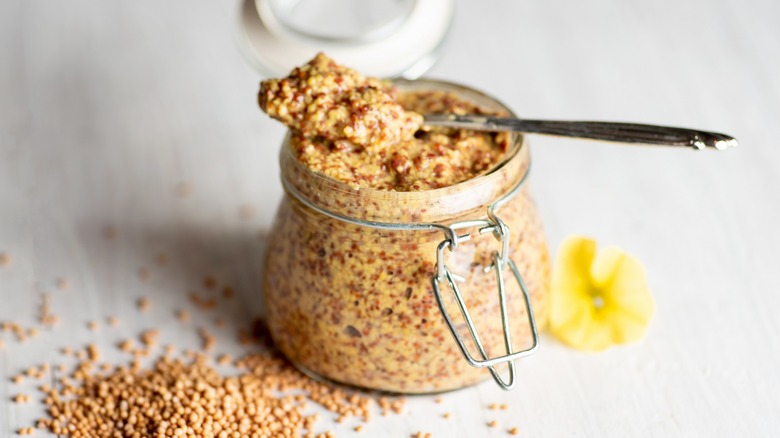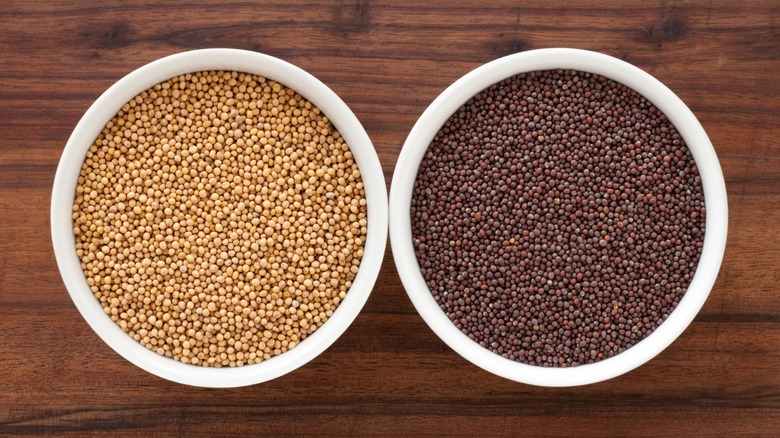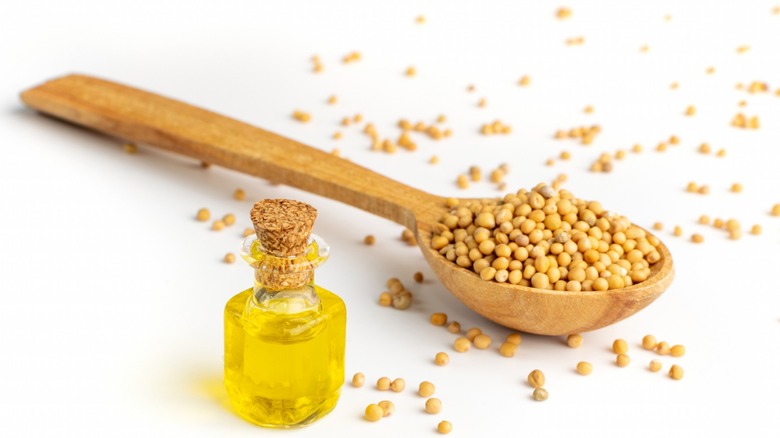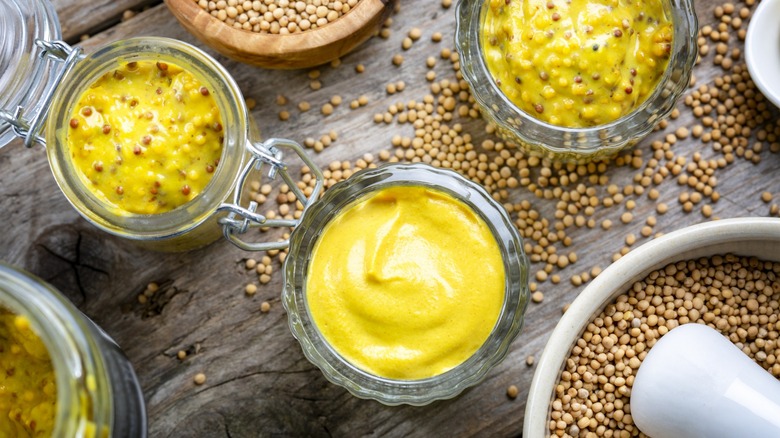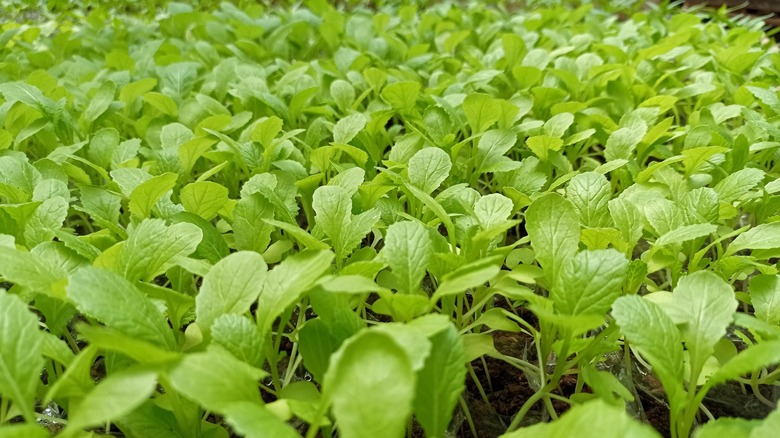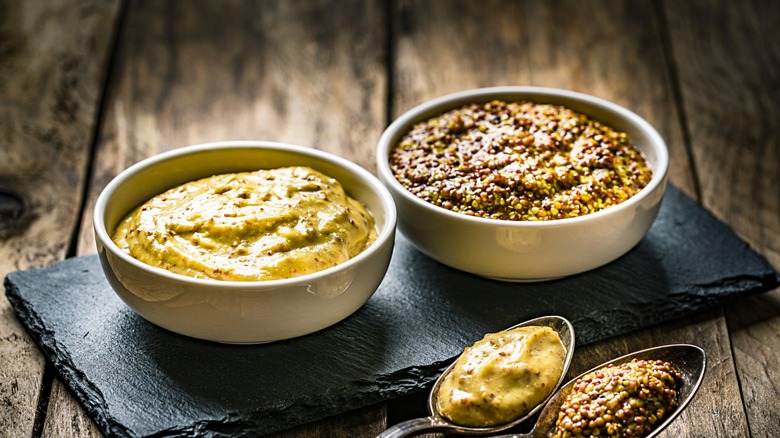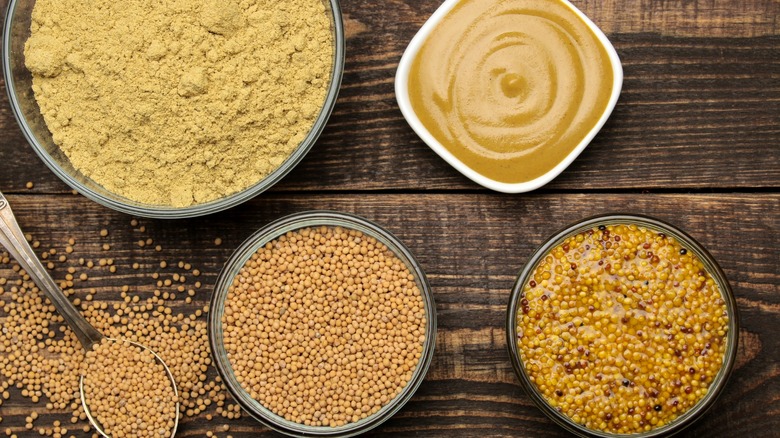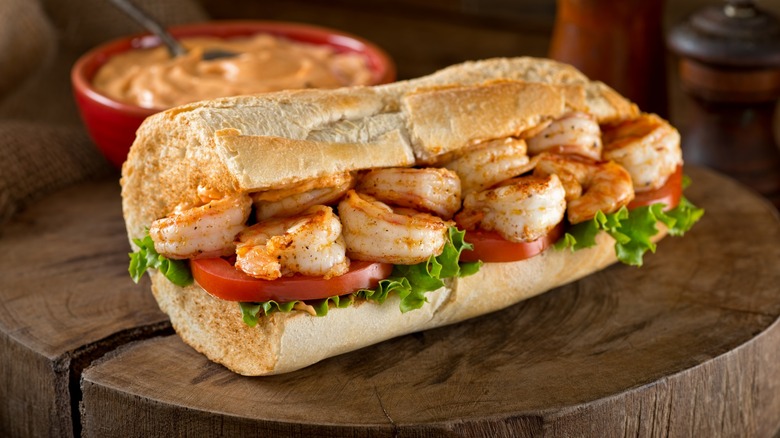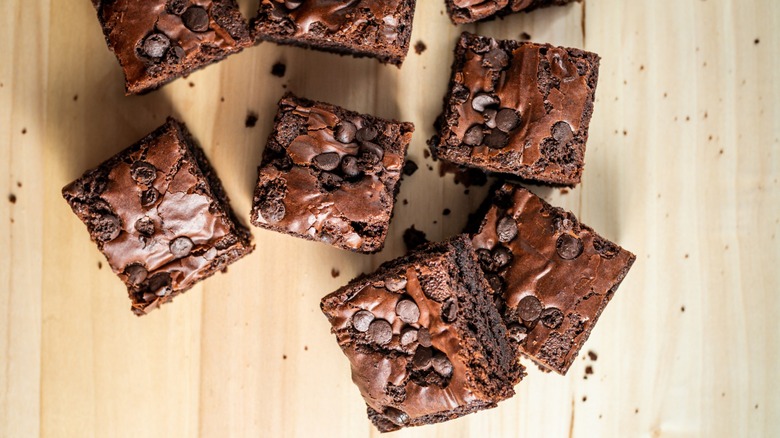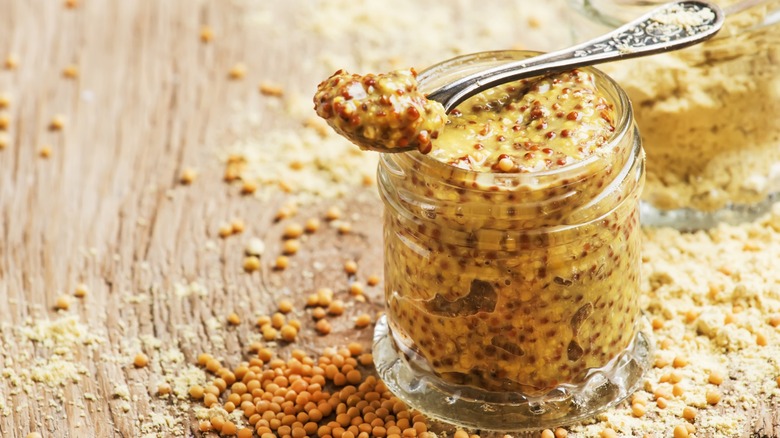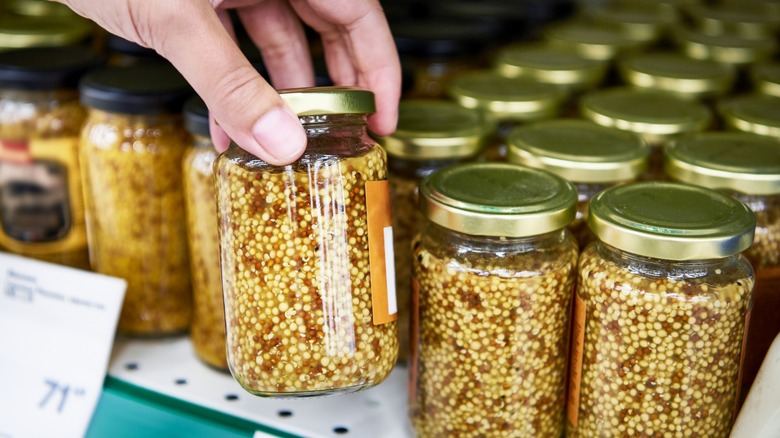Creole Mustard Is The Spiced Condiment You Need In Your Pantry
We may receive a commission on purchases made from links.
What do you like on your sandwiches? For many people, mayo is the go-to option. But mustard is a flexible condiment. With its many varieties, mustard is a culinary ingredient that can be used in ways never imagined for mayonnaise. Its tangy zest can upgrade an everyday sandwich, grace a gourmet meal, or reinvent an old standby.
Some of the most popular types of mustard are regional, such as Bavarian, Dijon, and Düsseldorf. But one style that you don't want to miss is Creole mustard. A local favorite in New Orleans, Creole mustard is used in recipes featuring pork chops, chicken, seafood, and much more. It spices up side dishes and sandwiches, and is an excellent addition to your charcuterie boards.
While it's not as well known as other varieties, Creole mustard's preparation makes it unique. Depending on where you buy it or the recipe used, it features a host of sweet, savory, and spicy ingredients, making this mustard quite distinctive. If you've never tried it, it's time to add this condiment to your culinary toolbox, as it makes the perfect secret ingredient to dazzle your dinner guests.
What is Creole mustard?
Creole mustard has become synonymous with Creole cooking. This unique flavor experience was created over centuries in and around New Orleans through the interactions of Native Americans, diverse settlers, and African Americans. Over time, they blended recipes with French, African, Caribbean, Italian, and Spanish cooking traditions, infusing transplanted foods like okra and regional ingredients like crawfish. With all these elements, Creole cooking was born.
Creole food is famed for its blend of spices, and Creole mustard is no different. While there are a few varieties, Creole mustard starts out a bit like many other mustards, with a blend of brown (and sometimes yellow) mustard seeds, vinegar, and some horseradish. But what makes this mustard unique is the addition of Creole seasoning, including paprika, garlic powder, onion powder, thyme, basil, and oregano. Next, it's sweetened with honey, molasses, or brown sugar. Creole mustard is a sweet and savory blend, with a kick of heat, and a perfect match for many Creole dishes.
However, there are many variations. For example, Zatarain's, a popular brand of Creole mustard, does not use horseradish, spices, or sweeteners in its recipe. This flexibility means that you can make a homemade version that is to your liking, with varying levels of spiciness. We prefer to wrinkle our noses with a spicy horseradish and mustard blend, but do what works for you without straying too far from real Creole flavor.
The origin and history of Creole mustard
Creole mustard is widely affiliated with New Orleans, but its true roots are cloaked in mystery. According to an interview with Emile Zatarain — the original owner of Zatarain's — that was archived by the Louisiana Digital Library, a German man named Wolff brought this type of mustard to New Orleans. Zatarain claimed that Wolff originally sold this mustard door-to-door.
In this interview, Zatarain claims that the first company to mass-produce Creole mustard was named Ginard or Guinard, which could refer to James Ginart; antique glass bottles of James Ginart Creole Mustard dated to the late 1800s are now sold as collector's items on eBay. The interview goes on to state that, perhaps due to Wolff's Germanic influence, Zatarain's Creole mustard originally included horseradish to emulate the style popular in Austrian mustards.
We know for certain that mustard has been used as a condiment in Europe for thousands of years. According to the Alimentarium, an ancient Roman mustard recipe dating back to the 4th century B.C. resembles the recipes we use today, with a blend of honey, vinegar, spices, and ground mustard seeds. With that historical fact, it would be difficult for any single person to take credit for what we now call the Creole mustard recipe. However, Emile Zatarain's Louisiana legacy and contributions to Creole cooking make his claims hard to refute.
Nutrition facts for Creole mustard
One of the great things about mustard of any variety is that it has less calories than many other condiments, making it a more appealing topping. Interestingly, most varieties of mustard contain two unique antioxidants. The first are molecules called isothiocyanates, which are believed to have properties that help prevent a variety of cancers. Some research also suggests that isothiocyanates can be helpful for diabetes patients, and can provide neurological benefits for people on the autism spectrum.
Mustard also contains sinigrin, which is linked to anti-cancer, antibacterial, antifungal, anti-inflammatory, and wound-healing properties. For both of these antioxidants, more research is necessary to confirm these health benefits.
That said, the typical serving size of mustard is not large enough to provide extensive antioxidant health benefits, though replacing higher-fat condiments with Creole mustard can be helpful for reducing calories. Regarding other nutritional values, Zatarain's Creole Mustard provides a good indication of how they measure up. A single teaspoon contains only five calories and 150 milligrams of sodium, with negligible amounts of anything else. But keep in mind that Zatarain's does not contain horseradish. That addition to the recipe will change the numbers.
How does Creole mustard compare to other mustard styles?
Every type of mustard contains mustard seeds, but that is where the similarities usually end. Let's see how Creole mustard measures up to other mustards. First up is spicy brown mustard, which is made quite similarly to Creole mustard. Both have a base of vinegar-marinated mustard seeds ground into a gritty format rather than finely ground, and both styles frequently contain horseradish. However, spicy brown mustard doesn't have any of the spices or sweeteners of the Creole version. That makes it much more pungent, so you experience the full force of the heat from the mustard seeds and horseradish.
Dijon mustard is quite different from Creole mustard for several reasons. First, its mustard seeds are finely ground, giving Dijon a smooth consistency and uniformly yellow appearance. On the other hand, Creole mustard is coarse and more brown in color when molasses is added, and it's often spicier than Dijon. However, the defining characteristic of Dijon is the addition of white wine, which is never included in typical Creole mustard recipes.
Another unique mustard type that is compared to Creole is German mustard. It's similar in that both styles are grainy and spicy. However, German mustard contains malt vinegar and often doesn't have any horseradish, making it milder. Since Creole mustard frequently contains potent doses of horseradish, its blend of sweeteners and spices can make it more like a recipe ingredient than a spicy condiment.
Growing mustard plants for Creole mustard
Brown and yellow mustard seeds are commonly used for Creole mustard, each with a unique flavor profile. Brown mustard seeds are spicy and tend to absorb liquid, making them great for wet recipes like vinaigrettes. Yellow mustard seeds are milder, so while some Creole mustards blend brown and yellow seeds, many Creole mustard recipes contain only brown seeds.
Mustard plants are easy to grow. However, it is a cool-weather plant, so temperatures over 75 degrees Fahrenheit are problematic for growing mustard. Fall or spring are the best planting seasons for mustard, but you may get better results and flavor by planting in the fall, avoiding exposure to high temperatures.
These plants require full sun exposure in your garden. Grow only one mustard variety at a time to avoid overtaxing the soil. Mustard plants should be spaced closely to combat weeds, unless you are transplanting a mature plant. They also need a fair amount of water and require well-draining soil that is slightly acidic and treated with nitrogen fertilizer. The entire plant is harvestable and edible, but we'll focus on collecting the seeds that make Creole mustard.
Once the plant begins to flower, wait for the pods to turn brown. After the pods naturally open, the seeds can scatter onto the ground, so be sure to harvest the pods before that happens. Once removed from the pods, it takes at least two weeks to air-dry the seeds for use.
Best recipes for Creole mustard
There are several ways to make homemade Creole mustard. The differences in recipes come down to seasonings. However, as mentioned, there is a lot of variety in the recipes for this mustard, such as what sweetener — if any — to use, whether horseradish is necessary, and whether or not to add herbs.
While you can make Creole mustard from scratch with your homegrown seeds, you will have to cure it for a few weeks before it is ready for use. A simpler and speedier option is to buy coarse stone-ground mustard and add Creole seasoning to the base. When creating your recipe, you can omit the horseradish. However, we recommend adding at least a little to make the flavor pop. You can also balance the horseradish with molasses or brown sugar to make your Creole mustard even more authentic.
When your recipe is complete, refrigerate it for at least a day or two to get the spices to blend perfectly throughout the mustard. Be sure to use an airtight container.
Substituting Creole mustard with other types of mustard
Traditional Creole mustard is unique, but unfortunately, it's not the most common type of mustard to buy ready-made at the grocery store. What if you need to substitute another mustard for a recipe that calls for Creole mustard? There are several options, but some work better than others.
Whole-grain mustard is the closest substitute option in flavor, but that also may be tough to find. Whole-grain mustard is made by grinding mustard seeds until they have a pasty consistency that is thicker and spicier than Creole mustard. It also can contain brown sugar, making it a closer match.
In addition to being difficult to find, whole-grain mustard has a rough texture and is very spicy. That impacts taste and spreadability. If that's a problem, the next best substitute is Dijon mustard, which is sometimes used as a base to make Creole mustard. Dijon has the right amount of heat, making it a great sub. While it's not as creamy as Creole mustard, adding the right spices to readily available Dijon mustard will do in a pinch.
Everyday spicy brown mustard is another option for a Creole mustard base. However, this variety is not as hot as the other two substitute options. You can doctor this version, but it might be just as much work as making Creole mustard from scratch. A final option is stone ground mustard, which has a smooth texture, so adding a dash of Creole seasoning works well.
Cooking tips for Creole mustard
Whether you've purchased a bottle or made your own, there are few rules to follow when cooking with Creole mustard, making it flexible. You can use it for sandwiches and dips, but the unique flavor lends well to several dishes.
When cooking with it, keep in mind that Creole mustard often contains horseradish or other elements that impart nose-wrinkling heat. Using too much horseradish can irritate the lining of your mouth or your stomach. If your dinner guests are sensitive to this heat, you may want to use a milder substitute. You'd normally need to consume fairly large amounts of horseradish to suffer a health crisis. That said, be careful when using Creole mustard. Avoid touching your eyes until you've washed your hands thoroughly.
Because of its heat and its spicy-sweet flavor, be judicious in how much you use in your recipe. You don't want to overpower the dish, be it a po' boy sandwich or a fancy meal. If the heat deters you from using it as a condiment, make Creole-style mayonnaise for the best of both worlds.
Creole mustard makes an excellent ingredient for a dipping sauce. This is the perfect side dish for a fried Louisiana-style boudin sausage ball appetizer. Or, spice up your everyday dinner routine with our chicken thighs braised with Creole mustard recipe.
Creative ways to serve Creole mustard
It's easy to use just about any mustard to heat up mayonnaise-based dishes, or add Creole mustard to liven up salmon or chicken entrees. But have you considered using Creole mustard for breakfast or dessert dishes?
For breakfast recipes calling for Dijon mustard, like egg casseroles, try replacing it with Creole mustard. For a simpler substitution, while Dijon mustard adds punch to scrambled eggs, using Creole mustard will add even more flavor. You're going to love adding a little Creole spin to wake up your mornings.
But did you know that you could also use Creole mustard for your desserts? Because it often contains sweeteners, this is not too surprising. You can create a rich cream sauce by blending a little Creole mustard with ingredients like cinnamon and bourbon. Or, you can fully embrace the spiciness of Creole mustard by pairing it with chocolate.
Mustard can be a great unexpected addition to brownies, for example. These tasty treats can often be super sweet, especially when made with chocolate chips mixed into the batter. The spice and sweet taste of Creole mustard can complement the richness of the cocoa. Chocolate also goes great with some of the hot spices in the mustard, adding a layer of complexity to this dessert. This will work best if you make your own recipe to better handle the mixture of the seasoning. Only use a small amount of mustard so you don't ruin the recipe.
Storing and preserving Creole mustard
It may seem like mustard can last forever, but just like other foods, it's sensitive to heat, light, and humidity. Improper storage can reduce flavor. If it's kept at temperatures above 70 degrees Fahrenheit, mustard can lose its spicy taste or even spoil. The best temperature for storing mustard is between 50 and 70 degrees Fahrenheit.
Sunlight can be a problem, too. The rays can actually change mustard's chemical composition, causing it to lose flavor or pungency. If you can't keep mustard out of sunlight, put it in an non-transparent container, especially if it's made from scratch.
Humidity can lead to mold, so make sure your storage area is dry. As mentioned, use an airtight container for storage to ensure the flavor and freshness lasts. Glass containers are the best choice, but if you must use plastic, use a food-grade, BPA-free container. You can also use a metal container, which ensures zero exposure to sunlight.
Always store opened mustard, whether it's homemade or store-bought, in your refrigerator. Throw out any expired mustard.
Where to buy Creole mustard
If you're looking for pre-made Creole mustard, Zatarain's is the most readily available brand. A 12-ounce bottle of Zatarain's Creole mustard is sold at Wegmans for $3.99, at Safeway for $4.49, or on Amazon for $2.88. Amazon also offers 10-ounce bottles of Maison Louisianne Creole Mustard for $8.99.
Another option is the NolaCajun online store that features local New Orleans cuisine, including plenty of Cajun mustards and seasonings. NolaCajun offers a 12-ounce bottle of Zatarain's Creole Mustard for $4.25, a 7-ounce bottle of Arnaud's Creole mustard for $6.45, and a bottle of Hanley's Sweet Creole Mustard Dressing/Sauce for $6.35.
If you are looking for mustard seeds for planting, you'll need to shop at a seed store. Purchase brown mustard seeds (Brassica juncea) at Sow True Seed for $3.25, while World Seed Supply offers yellow mustard seeds (Sinapsis alba) at for $1.99 for 375 seeds or $3.49 for an ounce of seeds.
